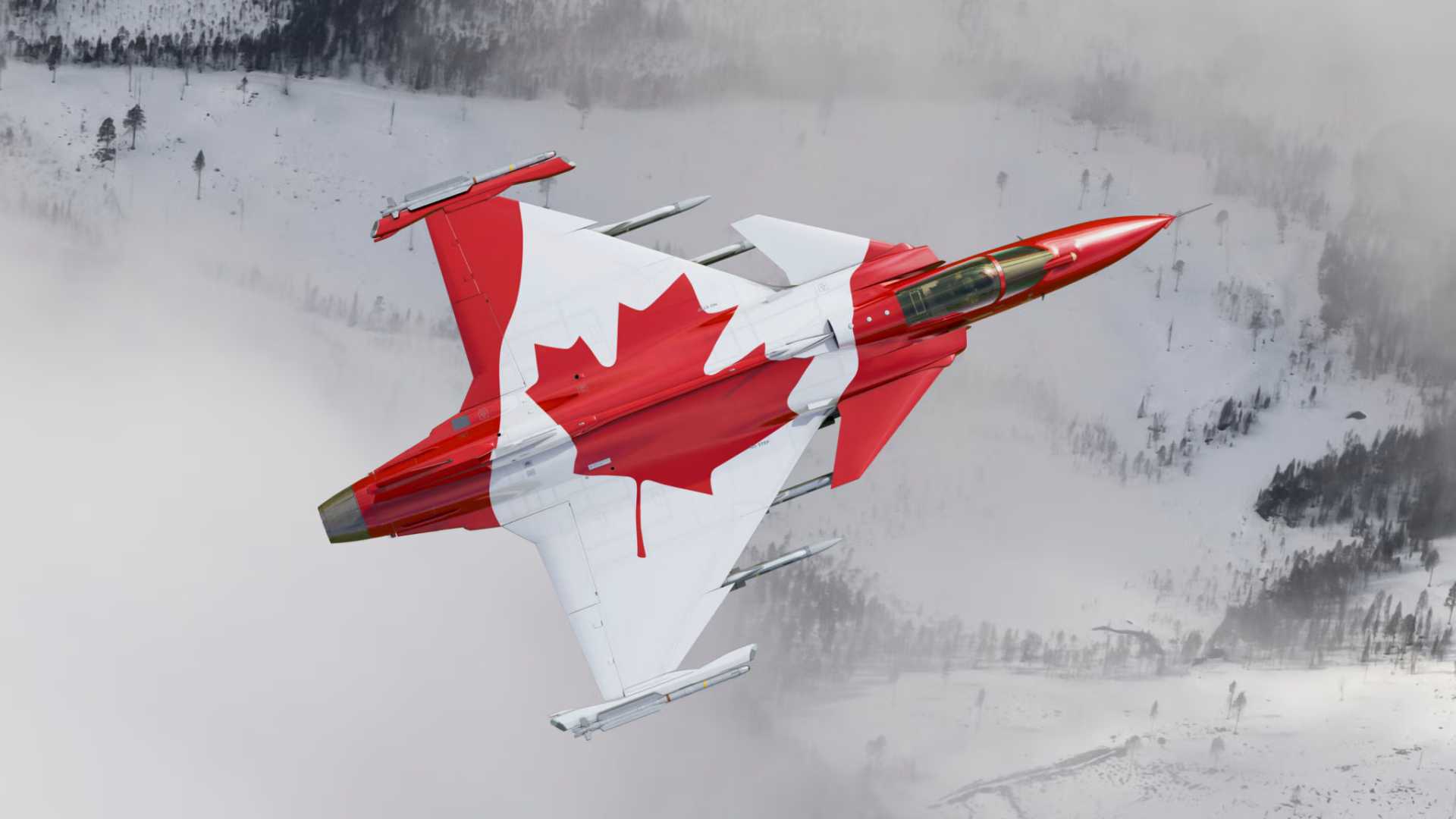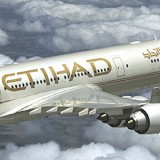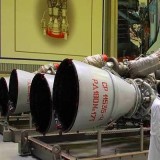Saab CEO confirms Gripen talks continue with Canada as the country reexamines its F-35 procurement

{loadposition bannertop}
{loadposition sidebarpub}
On April 6, 2025, Saab CEO Micael Johansson confirmed during an interview with Dagens industri that negotiations are ongoing with Canada regarding the JAS 39 Gripen fighter aircraft. He added that Saab is maintaining contacts with Portugal and continuing discussions with potential Gripen customers in Latin America. This follows the recent announcement by Colombian President Gustavo Petro regarding the acquisition of the Swedish JAS 39 Gripen fighter aircraft, marking a decisive step in the country’s longstanding effort to modernize its air force.Follow Army Recognition on Google News at this link
At the heart of Saab’s proposal is the Gripen E, which is optimized for Arctic environments and could be integrated with U.S. and other allied equipment to ensure interoperability. (Picture source: Saab)
Canada’s journey toward selecting a new fighter aircraft to replace its aging fleet of 98 CF-18A/B Hornet fighter jets, which entered Canadian service in 1982, has spanned more than a decade. Although Canada has been a partner in the F-35 development program since 1997, the selection process has experienced numerous reversals. The Canadian government initially announced its intention in 2010 to procure 65 F-35 Lightning II aircraft, citing the country’s status as a partner in the Joint Strike Fighter program. However, rising costs and delivery delays led to a withdrawal from that plan in 2012. Following the 2015 election of Prime Minister Justin Trudeau, the Liberal government reopened the fighter competition, citing the need for a more transparent and cost-effective procurement process. In December 2017, Canada launched an open bid for 88 new fighters, which included the F-35, Eurofighter Typhoon, Saab Gripen, Dassault Rafale, and Boeing F/A-18E/F Super Hornet.
By late 2018, Dassault withdrew its Rafale offer, citing concerns over Canadian requirements related to intelligence sharing and interoperability with U.S. forces. Saab formally submitted its Gripen E proposal to the Canadian government on July 31, 2020, backed by the Swedish state. The offer included 88 aircraft, a support and training package, and a comprehensive industrial and technology transfer program. The Super Hornet was excluded from the competition in December 2021, leaving the F-35 and Gripen E as the two remaining candidates. In March 2022, Canada declared its intention to enter into negotiations with Lockheed Martin, and in January 2023, it signed a final contract for 88 F-35s valued at 19 billion Canadian dollars (CAD). Despite this decision, Saab maintained that its proposal met all evaluation requirements and remained available should circumstances change.
Saab said that its Gripen proposal, submitted in 2019, fulfilled all of Canada’s procurement requirements, including those related to interoperability with NORAD and NATO. The company emphasized that its offer addressed operational needs through full technology transfer and assembly in Canada. Saab also stated that the Gripen was optimized for Arctic environments and could be integrated with U.S. and other allied equipment to ensure interoperability. In March 2019, Saab announced its readiness to deliver 88 Gripen E aircraft, establish manufacturing and maintenance facilities in Canada, and include American and other systems to align with U.S. and NATO operational frameworks. In January 2021, Saab offered to establish two aerospace centers in Canada to support these objectives. Saab’s offer passed all evaluation criteria, according to the company, including those related to industrial participation, capability, and security.
Throughout the evaluation process, Saab emphasized that the Gripen would offer Canada full sovereignty over its fighter operations and maintenance, in contrast to the U.S. model, which restricts testing and upgrades outside its borders. Saab highlighted the advantages of local assembly, long-term cost stability, and Canadian control over secure data. However, with Canada already committing funds for the first 16 F-35s, a reversal was seen as unlikely until March 2025. The shift began when Canadian Defence Minister Bill Blair publicly stated that Canada was reassessing whether the F-35 contract remained the best option for the Canadian Armed Forces, following major political changes from the U.S. Blair cited concerns about over-reliance on U.S. systems and emphasized that Canada would consult with alternative manufacturers. While the government has not officially cancelled the F-35 agreement, Laurent de Casanove, Blair’s press secretary, confirmed that while the contract remained valid for the first 16 aircraft, the government was reviewing whether the remaining portion of the agreement still aligned with Canadian defense priorities. Blair noted that adding a European aircraft could contribute to a more diversified fleet. The Gripen, which ranked second in the previous competition, has now reemerged as a likely candidate for a potential mixed-fleet solution.
Canada’s journey toward selecting a new fighter aircraft to replace its aging fleet of 98 CF-18A/B Hornet fighter jets, which entered Canadian service in 1982, has spanned more than a decade. (Picture source: Stuart Sanders via Facebook/Royal Canadian Air Force)
Saab’s proposal to Canada included a range of components beyond the delivery of the Gripen aircraft. The company offered to assemble, maintain, and upgrade the fleet in Canada through a national team, the Gripen for Canada Team, which includes IMP Aerospace and Defence, CAE, Arcfield Canada (formerly Peraton), and GE Aviation. Saab also committed to meeting Canada’s 100% guaranteed industrial offset requirements. The proposal projected the creation of 6,000 direct jobs annually over a 40-year period. Saab planned to establish a Gripen Centre in Montreal for fleet management, sustainment, mission system upgrades, and integration of NORAD and NATO capabilities. Additionally, Saab proposed a Cyber Resilience Centre in Toronto, a Sensor Centre in Vancouver, and an Aerospace R&D Centre in Montreal. The Aerospace R&D Centre would focus on unmanned aerial systems, artificial intelligence, and sustainable aviation technologies, in collaboration with Canadian academia and research institutions.
The Gripen Centre would be operated by Canadians and manage the mission system domestically, ensuring data control and sovereignty. According to Saab, this arrangement would allow Canada to conduct in-country technology upgrades and ensure compliance with NORAD and NATO operational standards. The Gripen Centre would also oversee repairs, fleet management, and modifications. The Aerospace R&D Centre would serve as a hub for collaborative innovation in aerospace development. Saab stated that these centers would contribute to long-term technological growth in Canada, enable global exports, and form an aerospace development cluster in Montreal.
Saab Canada has been active in the Canadian defense and security sector for over 30 years. The company maintains offices in Ottawa, Halifax, and Medicine Hat. Its systems are currently in service with the Canadian Army, Navy, Air Force, and various civil security agencies. Saab’s Carl Gustaf weapon system and associated ammunition are used by the Canadian Armed Forces. The Royal Canadian Navy’s Halifax-class frigates are equipped with Saab’s naval radars and fire control systems. Saab also provides live training and simulation equipment to Canadian government entities, including the Canadian Nuclear Safety Commission and the Parliamentary Protective Services.
In recent years, Saab has received multiple contracts from the Government of Canada. In December 2021, Saab was awarded a contract valued at more than SEK 300 million for Sea Giraffe AMB radar systems for the Halifax-class frigate upgrade. In February 2024, Saab received a CAD 227 million (SEK 1.8 billion) order for the RBS 70 NG short-range air defense system, with deliveries starting in 2024. Saab has also partnered with Tulmar Safety Systems in Ontario to produce advanced camouflage systems for domestic and international use. The company has submitted a proposal for the modernization of Canada’s Weapons Effects Simulation (WES) training program. Saab also promotes its GlobalEye Airborne Early Warning and Control (AEW&C) aircraft as a Canadian success story, as this aircraft, based on the Bombardier 6000/6500, is manufactured in part in Canada. Other contracts include the Sea Giraffe AMB radar upgrade for the Royal Canadian Navy and increased camouflage production in Ontario through partnerships with local companies.
Canadian Defence Minister Bill Blair recently stated that Canada was reassessing whether the F-35 contract remained the best option for the Canadian Armed Forces, following major political changes from the U.S. (Picture source: US DoD)
At the heart of Saab’s fighter jet proposal is the Gripen E, described by the company as a modular and upgradeable platform. It features a General Electric F414-GE-39E engine producing 98 kN of thrust, a maximum take-off weight of 16,500 kg, and ten external hardpoints. The aircraft can reach Mach 2, operate at altitudes above 16,000 meters, and is equipped for air-to-air refueling. The combat radius is 810 nautical miles with aerial refueling, and ferry range is 2,160 nautical miles. The Gripen E is armed with a Mauser BK27 mm cannon and can carry air-to-air and air-to-surface weapons, including the Meteor and IRIS-T missiles.
The aircraft’s avionics system includes an Active Electronically Scanned Array (AESA) radar, Infrared Search and Track (IRST), and a Multi-Functional Electronic Warfare system. Gripen E is designed to detect, classify, and counter threats in real-time. Its cockpit includes a Wide Area Display (WAD), a Head-Up Display (HUD), and a Targo Helmet Mounted Display. The avionics architecture separates flight-critical and mission software, allowing for faster and more frequent upgrades. According to Saab, this enables users to update capabilities in response to operational requirements without extensive delays or recertification.
Additionally, the Gripen E is designed for high availability and short turnaround times. It can be refueled and rearmed in less than 20 minutes with a limited number of ground crew. The aircraft can operate from short or dispersed runways, including road bases. Saab states that these features allow for operations in dispersed environments and increased fleet survivability. The Gripen E includes electronic countermeasures such as expendable active decoys, radar warning receivers, and a missile approach warning system. These systems are intended to reduce the risk of detection and increase survivability in contested airspace.
The Gripen is also designed for interoperability with allied forces through shared datalinks and standardized communication systems. Gripen E’s systems support compliance with NATO and NORAD operational protocols. Saab states that its sensor and communication systems allow the aircraft to operate as part of a networked force, with the ability to share and receive targeting data across platforms. This configuration supports silent operation and coordinated mission execution. Saab’s proposal to Canada emphasized full control over secure data and mission systems, which would be hosted domestically at the proposed Gripen Centre in Montreal.

{loadposition bannertop}
{loadposition sidebarpub}
On April 6, 2025, Saab CEO Micael Johansson confirmed during an interview with Dagens industri that negotiations are ongoing with Canada regarding the JAS 39 Gripen fighter aircraft. He added that Saab is maintaining contacts with Portugal and continuing discussions with potential Gripen customers in Latin America. This follows the recent announcement by Colombian President Gustavo Petro regarding the acquisition of the Swedish JAS 39 Gripen fighter aircraft, marking a decisive step in the country’s longstanding effort to modernize its air force.
Follow Army Recognition on Google News at this link
At the heart of Saab’s proposal is the Gripen E, which is optimized for Arctic environments and could be integrated with U.S. and other allied equipment to ensure interoperability. (Picture source: Saab)
Canada’s journey toward selecting a new fighter aircraft to replace its aging fleet of 98 CF-18A/B Hornet fighter jets, which entered Canadian service in 1982, has spanned more than a decade. Although Canada has been a partner in the F-35 development program since 1997, the selection process has experienced numerous reversals. The Canadian government initially announced its intention in 2010 to procure 65 F-35 Lightning II aircraft, citing the country’s status as a partner in the Joint Strike Fighter program. However, rising costs and delivery delays led to a withdrawal from that plan in 2012. Following the 2015 election of Prime Minister Justin Trudeau, the Liberal government reopened the fighter competition, citing the need for a more transparent and cost-effective procurement process. In December 2017, Canada launched an open bid for 88 new fighters, which included the F-35, Eurofighter Typhoon, Saab Gripen, Dassault Rafale, and Boeing F/A-18E/F Super Hornet.
By late 2018, Dassault withdrew its Rafale offer, citing concerns over Canadian requirements related to intelligence sharing and interoperability with U.S. forces. Saab formally submitted its Gripen E proposal to the Canadian government on July 31, 2020, backed by the Swedish state. The offer included 88 aircraft, a support and training package, and a comprehensive industrial and technology transfer program. The Super Hornet was excluded from the competition in December 2021, leaving the F-35 and Gripen E as the two remaining candidates. In March 2022, Canada declared its intention to enter into negotiations with Lockheed Martin, and in January 2023, it signed a final contract for 88 F-35s valued at 19 billion Canadian dollars (CAD). Despite this decision, Saab maintained that its proposal met all evaluation requirements and remained available should circumstances change.
Saab said that its Gripen proposal, submitted in 2019, fulfilled all of Canada’s procurement requirements, including those related to interoperability with NORAD and NATO. The company emphasized that its offer addressed operational needs through full technology transfer and assembly in Canada. Saab also stated that the Gripen was optimized for Arctic environments and could be integrated with U.S. and other allied equipment to ensure interoperability. In March 2019, Saab announced its readiness to deliver 88 Gripen E aircraft, establish manufacturing and maintenance facilities in Canada, and include American and other systems to align with U.S. and NATO operational frameworks. In January 2021, Saab offered to establish two aerospace centers in Canada to support these objectives. Saab’s offer passed all evaluation criteria, according to the company, including those related to industrial participation, capability, and security.
Throughout the evaluation process, Saab emphasized that the Gripen would offer Canada full sovereignty over its fighter operations and maintenance, in contrast to the U.S. model, which restricts testing and upgrades outside its borders. Saab highlighted the advantages of local assembly, long-term cost stability, and Canadian control over secure data. However, with Canada already committing funds for the first 16 F-35s, a reversal was seen as unlikely until March 2025. The shift began when Canadian Defence Minister Bill Blair publicly stated that Canada was reassessing whether the F-35 contract remained the best option for the Canadian Armed Forces, following major political changes from the U.S. Blair cited concerns about over-reliance on U.S. systems and emphasized that Canada would consult with alternative manufacturers. While the government has not officially cancelled the F-35 agreement, Laurent de Casanove, Blair’s press secretary, confirmed that while the contract remained valid for the first 16 aircraft, the government was reviewing whether the remaining portion of the agreement still aligned with Canadian defense priorities. Blair noted that adding a European aircraft could contribute to a more diversified fleet. The Gripen, which ranked second in the previous competition, has now reemerged as a likely candidate for a potential mixed-fleet solution.

Canada’s journey toward selecting a new fighter aircraft to replace its aging fleet of 98 CF-18A/B Hornet fighter jets, which entered Canadian service in 1982, has spanned more than a decade. (Picture source: Stuart Sanders via Facebook/Royal Canadian Air Force)
Saab’s proposal to Canada included a range of components beyond the delivery of the Gripen aircraft. The company offered to assemble, maintain, and upgrade the fleet in Canada through a national team, the Gripen for Canada Team, which includes IMP Aerospace and Defence, CAE, Arcfield Canada (formerly Peraton), and GE Aviation. Saab also committed to meeting Canada’s 100% guaranteed industrial offset requirements. The proposal projected the creation of 6,000 direct jobs annually over a 40-year period. Saab planned to establish a Gripen Centre in Montreal for fleet management, sustainment, mission system upgrades, and integration of NORAD and NATO capabilities. Additionally, Saab proposed a Cyber Resilience Centre in Toronto, a Sensor Centre in Vancouver, and an Aerospace R&D Centre in Montreal. The Aerospace R&D Centre would focus on unmanned aerial systems, artificial intelligence, and sustainable aviation technologies, in collaboration with Canadian academia and research institutions.
The Gripen Centre would be operated by Canadians and manage the mission system domestically, ensuring data control and sovereignty. According to Saab, this arrangement would allow Canada to conduct in-country technology upgrades and ensure compliance with NORAD and NATO operational standards. The Gripen Centre would also oversee repairs, fleet management, and modifications. The Aerospace R&D Centre would serve as a hub for collaborative innovation in aerospace development. Saab stated that these centers would contribute to long-term technological growth in Canada, enable global exports, and form an aerospace development cluster in Montreal.
Saab Canada has been active in the Canadian defense and security sector for over 30 years. The company maintains offices in Ottawa, Halifax, and Medicine Hat. Its systems are currently in service with the Canadian Army, Navy, Air Force, and various civil security agencies. Saab’s Carl Gustaf weapon system and associated ammunition are used by the Canadian Armed Forces. The Royal Canadian Navy’s Halifax-class frigates are equipped with Saab’s naval radars and fire control systems. Saab also provides live training and simulation equipment to Canadian government entities, including the Canadian Nuclear Safety Commission and the Parliamentary Protective Services.
In recent years, Saab has received multiple contracts from the Government of Canada. In December 2021, Saab was awarded a contract valued at more than SEK 300 million for Sea Giraffe AMB radar systems for the Halifax-class frigate upgrade. In February 2024, Saab received a CAD 227 million (SEK 1.8 billion) order for the RBS 70 NG short-range air defense system, with deliveries starting in 2024. Saab has also partnered with Tulmar Safety Systems in Ontario to produce advanced camouflage systems for domestic and international use. The company has submitted a proposal for the modernization of Canada’s Weapons Effects Simulation (WES) training program. Saab also promotes its GlobalEye Airborne Early Warning and Control (AEW&C) aircraft as a Canadian success story, as this aircraft, based on the Bombardier 6000/6500, is manufactured in part in Canada. Other contracts include the Sea Giraffe AMB radar upgrade for the Royal Canadian Navy and increased camouflage production in Ontario through partnerships with local companies.

Canadian Defence Minister Bill Blair recently stated that Canada was reassessing whether the F-35 contract remained the best option for the Canadian Armed Forces, following major political changes from the U.S. (Picture source: US DoD)
At the heart of Saab’s fighter jet proposal is the Gripen E, described by the company as a modular and upgradeable platform. It features a General Electric F414-GE-39E engine producing 98 kN of thrust, a maximum take-off weight of 16,500 kg, and ten external hardpoints. The aircraft can reach Mach 2, operate at altitudes above 16,000 meters, and is equipped for air-to-air refueling. The combat radius is 810 nautical miles with aerial refueling, and ferry range is 2,160 nautical miles. The Gripen E is armed with a Mauser BK27 mm cannon and can carry air-to-air and air-to-surface weapons, including the Meteor and IRIS-T missiles.
The aircraft’s avionics system includes an Active Electronically Scanned Array (AESA) radar, Infrared Search and Track (IRST), and a Multi-Functional Electronic Warfare system. Gripen E is designed to detect, classify, and counter threats in real-time. Its cockpit includes a Wide Area Display (WAD), a Head-Up Display (HUD), and a Targo Helmet Mounted Display. The avionics architecture separates flight-critical and mission software, allowing for faster and more frequent upgrades. According to Saab, this enables users to update capabilities in response to operational requirements without extensive delays or recertification.
Additionally, the Gripen E is designed for high availability and short turnaround times. It can be refueled and rearmed in less than 20 minutes with a limited number of ground crew. The aircraft can operate from short or dispersed runways, including road bases. Saab states that these features allow for operations in dispersed environments and increased fleet survivability. The Gripen E includes electronic countermeasures such as expendable active decoys, radar warning receivers, and a missile approach warning system. These systems are intended to reduce the risk of detection and increase survivability in contested airspace.
The Gripen is also designed for interoperability with allied forces through shared datalinks and standardized communication systems. Gripen E’s systems support compliance with NATO and NORAD operational protocols. Saab states that its sensor and communication systems allow the aircraft to operate as part of a networked force, with the ability to share and receive targeting data across platforms. This configuration supports silent operation and coordinated mission execution. Saab’s proposal to Canada emphasized full control over secure data and mission systems, which would be hosted domestically at the proposed Gripen Centre in Montreal.




